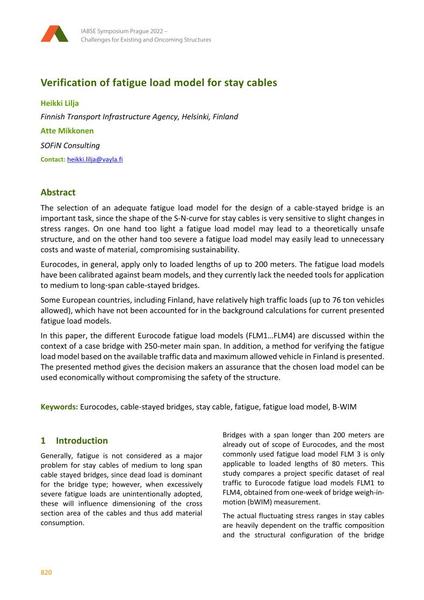Verification of fatigue load model for stay cables

|
|
|||||||||||
Bibliographic Details
| Author(s): |
Heikki Lilja
(Finnish Transport Infrastructure Agency, Helsinki, Finland)
Atte Mikkonen (SOFiN Consulting) |
||||
|---|---|---|---|---|---|
| Medium: | conference paper | ||||
| Language(s): | English | ||||
| Conference: | IABSE Symposium: Challenges for Existing and Oncoming Structures, Prague, Czech Republic, 25-27 May 2022 | ||||
| Published in: | IABSE Symposium Prague 2022 | ||||
|
|||||
| Page(s): | 820-828 | ||||
| Total no. of pages: | 9 | ||||
| DOI: | 10.2749/prague.2022.0820 | ||||
| Abstract: |
The selection of an adequate fatigue load model for the design of a cable-stayed bridge is an important task, since the shape of the S-N-curve for stay cables is very sensitive to slight changes in stress ranges. On one hand too light a fatigue load model may lead to a theoretically unsafe structure, and on the other hand too severe a fatigue load model may easily lead to unnecessary costs and waste of material, compromising sustainability. Eurocodes, in general, apply only to loaded lengths of up to 200 meters. The fatigue load models have been calibrated against beam models, and they currently lack the needed tools for application to medium to long-span cable-stayed bridges. Some European countries, including Finland, have relatively high traffic loads (up to 76 ton vehicles allowed), which have not been accounted for in the background calculations for current presented fatigue load models. In this paper, the different Eurocode fatigue load models (FLM1…FLM4) are discussed within the context of a case bridge with 250-meter main span. In addition, a method for verifying the fatigue load model based on the available traffic data and maximum allowed vehicle in Finland is presented. The presented method gives the decision makers an assurance that the chosen load model can be used economically without compromising the safety of the structure. |
||||
| Keywords: |
cable-stayed bridges fatigue stay cable Eurocodes B-WIM Fatigue Load Model
|
||||
| Copyright: | © 2022 International Association for Bridge and Structural Engineering (IABSE) | ||||
| License: | This creative work is copyrighted material and may not be used without explicit approval by the author and/or copyright owner. |
||||
